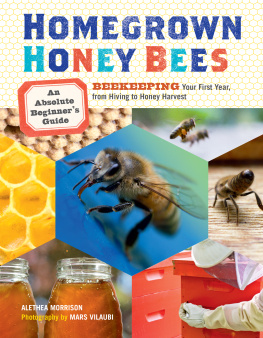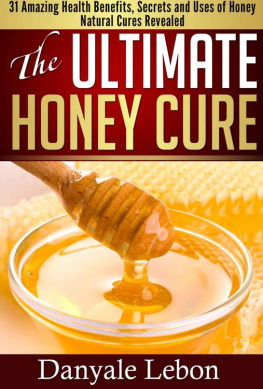THE MIRACLE OF
HONEY
Practical Tips for
HEALTH, HOME
& BEAUTY
DR PENNY STANWAY

DEDICATION
This book is dedicated to all those family members and friends who have joined me in the delightful pursuit of tasting honeys from around the world.
Dr Penny Stanway practised for several years as a GP and as a child-health doctor before becoming increasingly fascinated by researching and writing about a healthy diet and other natural approaches to health and wellbeing. She is an accomplished cook who loves eating and very much enjoys being creative in the kitchen and sharing food with others. Penny has written more than 20 books on health, food and the connections between the two. She lives with her husband in a houseboat on the Thames and often visits the south-west of Ireland. Her leisure pursuits include painting, swimming and being with her family and friends.
By the same author:
The Miracle of Lemons
The Miracle of Cider Vinegar
The Miracle of Bicarbonate of Soda (US The Miracle of Baking Soda)
The Miracle of Olive Oil
The Miracle of Garlic
The Natural Guide to Womens Health
Healing Foods for Common Ailments
Good Food for Kids
Free Your Inner Artist
Breast is Best (revised and updated sixth edition, 2012)
As co-author:
Christmas A Cooks Tour
The Lunchbox Book
Feeding Your Baby
Contents
Introduction
Honey is a fragrant food made by honeybees. In ancient times, it was considered a food of the gods, a symbol of wealth, health and happiness and even an elixir of immortality. The Old Testament promised the Israelites a land flowing with milk and honey. Egyptian doctors used honey-containing remedies 5,000 years ago. Mohammed claimed it was a remedy for every illness. And Hindus still use it today as one of the five foods offered in worship or welcome.
The word honey comes from oneg, Hebrew for delight. Honey is also known as the food of love. Indeed, the word honeymoon references the ancient Viking custom in which bride and groom consumed honey cakes and mead (a drink made by fermenting honey) for a month after betrothal. Today, bridegrooms in Morocco may follow tradition by feasting on honey.
A 100-million-year-old bee was recently found preserved in amber. We know people ate honey many thousands of years ago, but they have probably done so for much longer. They began by collecting honey from wild bees nests, then progressed to keeping bees. Beekeeping was especially popular in Europe and so common in ancient Britain that it was called the land of honey.
At first, honey was the only sweetener other than date, fig or maple syrup. Alexander the Great brought sugar cane from India to Greece in the 4th century bc. But only the rich could afford this honey reed until the mass cultivation of sugar cane and sugar beet began in the 18th century. As sugar became more affordable, honey became less important.
The worldwide production of honey in 2010 was 1.4 million metric tons. China was the main honey-producer (22 per cent of global production), followed by the European Union (14 per cent), Argentina and the US (6 per cent each) and Turkey (5 per cent). Other honey producers, in order, are Ukraine, Mexico, the Russian Federation, Iran, Ethiopia, India, Tanzania, Spain, Canada, Kenya, Germany, Angola and Australia.
Honey consumption today is greatest in Greece at 1.62kg/3lb 5oz per person per year and lowest in Hungary at 0.18kg/6oz. In Canada, it is 0.78kg/1lb 11oz; Australia 0.6kg/1lb 4oz; the UK 0.59kg/1lb 5oz, the US 0.58kg/1.3lb and China 0.2kg/6oz.
In contrast, many consumers eat vastly more sugar. For example, the average person in the US consumes more than 70kg/156lb of sugar, including high-fructose corn syrup, each year which is an awful lot of empty calories.
Neither the US nor most EU countries produce enough honey to meet their needs, so rely on imports. Britain produced only 15 per cent of its needs in 2009. And in 2010, Germany imported 80 per cent of the honey consumed there.
About 85 per cent of global production goes to consumers as table honey, the rest to the food industry for bakery, confectionery and breakfast cereals, for example. There is also a small market for honey in the pharmaceutical and tobacco industries.
The colour, consistency, fragrance and flavour of honey vary according to its nectar and honeydew sources as well as types of processing. Multifloral and blended honeys are most common, although consumers increasingly pay a premium for monofloral, raw or organic honey, and there is growing interest in darker, stronger-tasting honeys. Because just as wine or olive-oil aficionados delight in the differences between wines or oils from different seasons, producers and varieties of grape or olive, so too do honey lovers enjoy different honeys.
But not all is sweetness and light. Too many honeybees are dying, possibly because of pesticides, wildflower losses and bee malnutrition.
Hopefully, with care and research, our supplies of honey and, most important, the pollination of food and other crops by honeybees will become more secure and thus guarantee the survival of the honeybee.
CHAPTER ONE
Bees and Honey
Honeybees change nectar from flowers into honey, to make food for themselves. The average hive stores 914kg/2030lb of honey by the end of the year. This represents a huge joint effort because a single worker bee produces only half a teaspoon of honey in her whole life. It takes nectar collections from around 2.6 million flowers, involving bee flights totalling around 88,000km/55,000 miles, to produce just 450g/1lb of honey.
The dates in this chapter are for temperate countries in the northern hemisphere. Adjust them by six months for temperate countries in the southern hemisphere.
Honeybees
Only a few of the 25,000 or so species of bee make honey, and most of these produce only tiny amounts.
Honeybees inhabit every continent except Antarctica. Apis melllifera is the most common type in Europe, the US, Canada and Australia. Honeybees live in large colonies and store a lot of honey. In contrast, the bumblebee (Bombus bombus) lives in a small colony that stores a tablespoon at most.
Honeybee varieties differ in honey-making ability, honeycomb colour and building, hive-care, immunity, tendency to swarm (form a new colony), multiplication, appetite and character. The most popular are Italians (brown-and-yellow-striped), Carniolans (black or grey) and Caucasians (grey). Thanks to migration and importation, though, many honeybees are mongrels today.
From here on Ill generally call honeybees simply bees.
A bee colony
A bee colony or family consists of:
A queen bee the only fertile female. She lays eggs, keeps the colony happy, is the longest bee and lives 18 months on average, although she can survive up to six years.
Up to 30,000-60,000 worker bees small infertile females that groom and feed other bees, maintain the hive, collect nectar, pollen, propolis and water, and make honey. A spring- or summer-born worker lives six weeks at most, an autumn-born one six months.















